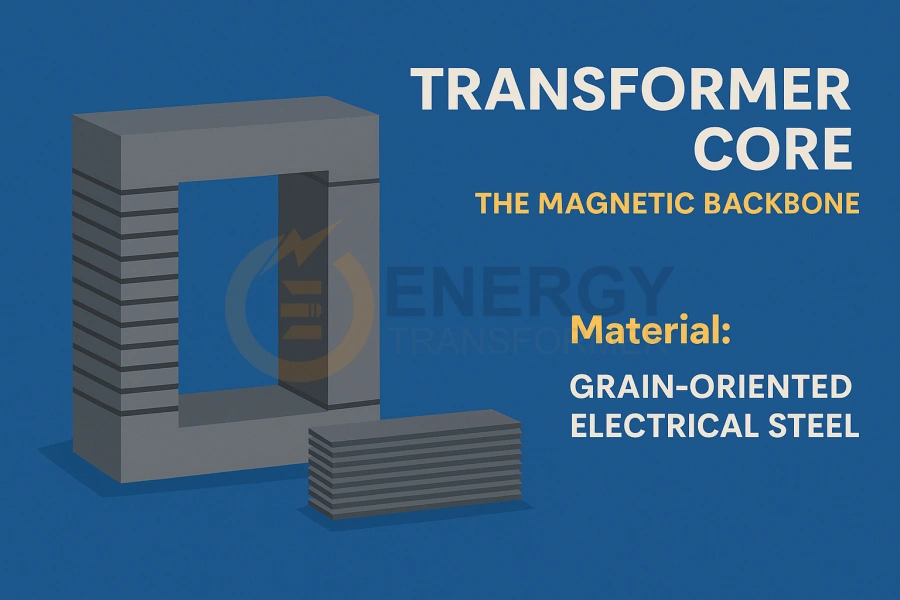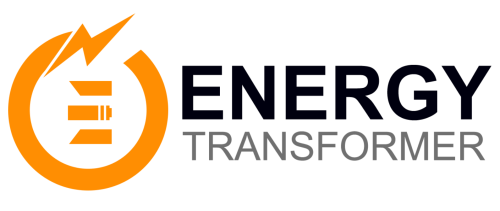Understand the Internal Structure of Transformers Before You Purchase or Specify
Power transformers are the unsung heroes of our electrical grids, silently converting voltage levels to ensure efficient and reliable power delivery. But what exactly goes on inside these robust machines? For industrial buyers, specifying engineers, and project managers, a solid understanding of the power transformer structure and its transformer internal parts is not just academic—it's crucial for making informed purchasing decisions, ensuring long-term reliability, and optimizing system performance.
This guide from Energy Transformer, one of China's best power transformer manufacturers, delves into the essential transformer components that make these devices work.
Overview: What Are the Key Parts of a Transformer?
At their heart, all transformers rely on three fundamental key parts of a transformer working in harmony:
-
The Core: The magnetic path.
-
The Windings: The electrical conductors that carry current.
-
The Insulation System: The protective barrier preventing short circuits.
These main parts of a transformer are encased within a tank (for liquid-filled units) or an enclosure (for dry-type units), along with various other accessories for cooling and monitoring.
Get More:What Is an Electrical Transformer? Function, Design, and Working Principle
Transformer Core – The Magnetic Backbone
The transformer core is the essential magnetic backbone of the device, providing a low-reluctance path for the magnetic flux. Its primary function is to efficiently couple the magnetic energy between the primary and secondary windings.
-
Material: Cores are typically made from thin laminations of grain-oriented electrical steel (silicon steel) due to its high magnetic permeability and low hysteresis losses. More advanced designs might use iron-nickel alloys for specific applications.
-
Types of Transformer Cores:
-
Laminated Core: The most common type, constructed from stacks of thin silicon steel sheets, which are insulated from each other to reduce eddy current losses. These can be E-I type, U-I type, or shell type.
-
Wound Core (Toroidal Core): Made from a continuous strip of steel wound into a coil. This type often offers superior magnetic performance but can be more complex to wind.
-
-
Design Considerations: The design of the core focuses on reducing core losses such as hysteresis loss (energy dissipated as heat due to the magnetization and demagnetization cycles) and eddy current loss (circulating currents induced within the core material itself). These losses, collectively known as no-load losses or iron losses, are directly related to the core's material quality and design. A well-designed core is paramount for transformer efficiency.
Read More:Transformer Efficiency Standards and Loss Analysis: A Complete Guide (IEC & DOE Compliant)

Transformer Windings – Primary and Secondary Conductors
The transformer windings are the conductive coils that facilitate the transfer of electrical energy. There are two main sets:
-
Primary Windings: These coils are connected to the input power source, where electrical energy enters the transformer.
-
Secondary Windings: These coils are connected to the load, delivering the transformed electrical energy at the desired voltage level.
-
Materials: Copper winding transformers are highly efficient due to copper's excellent conductivity and mechanical strength. Aluminum winding transformers are a more cost-effective alternative, offering a lighter weight solution. Both materials are widely used, with the choice often depending on cost, size, and specific application requirements.
-
Arrangement and Forms: Windings can be arranged in various forms like layer windings, helical windings, disc windings, or sandwich windings, each optimized for different voltage levels, current capacities, and short-circuit withstand capabilities.
-
Insulation Coating: Each turn of the conductor is covered with an insulation layer (e.g., enamel, paper) to prevent short circuits between turns. The overall conductor cross-sectional area directly impacts the transformer's current-carrying capacity and efficiency. Larger conductors result in lower load losses (also known as copper losses or losses) and less heat generation, contributing to better efficiency and longer life.
Insulation System – Ensuring Electrical Isolation and Thermal Stability
The transformer insulation system is arguably one of the most critical elements, ensuring the electrical isolation between live parts and preventing short circuits, arcing, and breakdowns. It also plays a vital role in the transformer's thermal stability and overall lifespan.
-
Function: The primary role of transformer insulation materials is to separate the turns within a winding, the windings from each other, and the windings from the core and tank. This prevents unwanted current paths and ensures the safe operation of the transformer.
-
Types of Insulation:
-
Solid Insulation: Common materials include insulation paper (e.g., Kraft paper), pressboard, epoxy resins (especially in dry-type transformers), and laminated wood. These provide dielectric strength and mechanical support.
-
Liquid Insulation: Transformer oil (mineral oil, natural esters, synthetic esters) is widely used in oil-immersed transformers. It serves as both a dielectric medium and a cooling agent, dissipating heat generated by the core and windings.
-
Gaseous Insulation: Air is the primary insulating medium in dry-type transformers. For higher voltage or specialized applications, Sulfur Hexafluoride (SF₆) gas can also be used, offering excellent dielectric properties.
-
-
Thermal Class and Lifespan: The insulation class defines the maximum permissible operating temperature. The insulation system's aging and degradation are highly temperature-dependent. Over time, insulation deteriorates, reducing its dielectric strength and mechanical integrity, which is a leading cause of transformer failure. Understanding transformer aging and insulation life is vital for maintenance and lifespan predictions.
Read More:Basic Transformer Ratings Explained kVA, Voltage, Frequency & Impedance for Buyers and Engineers
Interaction Between Core, Windings, and Insulation
The brilliance of transformer design principles lies in the seamless electromagnetic coupling and synergistic interaction between the core, windings, and insulation. The core guides the magnetic flux generated by the primary winding, inducing voltage in the secondary. The windings efficiently transfer this electrical energy. All the while, the insulation system protects these conductive elements from each other and from ground, ensuring the integrity of the electrical path.
Heat dissipation is a critical aspect of this interaction. Losses in both the core and windings generate heat. The insulation system must not only withstand the electrical stress but also the thermal stress. Effective cooling mechanisms, whether relying on the insulating liquid, air, or forced cooling systems, are designed around the heat generated by these primary components.
Additional Structural Elements
While the core, windings, and insulation are the foundational elements, a complete power transformer includes several other vital structural elements:
-
Transformer Tank/Enclosure: The main housing that protects the internal components from the environment. Oil-filled transformers use a robust steel tank for the oil, while dry-type transformers utilize an enclosure with ventilation.
-
Cooling System: This can range from natural air cooling (AN), forced air cooling (AF), natural oil cooling (ONAN), or forced oil cooling with heat exchangers.
-
Bushings: Insulated terminals that allow electrical connections to the windings while maintaining insulation from the tank/enclosure.
-
Tap Changer: Allows for minor adjustments to the voltage ratio to compensate for line voltage variations.
-
Conservator (for oil-filled): An external tank that allows for expansion and contraction of transformer oil due to temperature changes.
-
Pressure Relief Device: Vents excessive internal pressure to prevent catastrophic failure.
-
Temperature Gauges & Oil Level Indicators: Monitoring devices for safe operation and maintenance.
-
Radiators/Fins: External surfaces that increase the cooling area for oil-filled transformers.
Learn More:High Voltage vs. Low Voltage Transformers: Key Differences and Real-World Applications
Why These Components Matter to Buyers
For industrial buyers, understanding the internal structure of transformers and the materials used is not just technical jargon—it's directly linked to transformer quality factors, performance, and total cost of ownership:
-
Longevity and Reliability: High-quality core steel, proper winding materials (copper often preferred for its robustness), and superior insulation directly contribute to the transformer's lifespan and ability to withstand operational stresses. Poor quality materials can lead to premature aging and failure.
-
Efficiency: The design and materials of the core and windings are major determinants of efficiency. Lower core losses and winding losses mean less wasted energy and lower operating costs over the transformer's lifetime.
-
Cost: While more robust materials or advanced designs might mean a higher initial purchase price, they often translate to lower maintenance costs and energy bills in the long run.
-
Customization and OEM Transformers: When considering an OEM transformer or a custom transformer design, knowledge of these components allows for more effective communication with manufacturers, ensuring the final product meets your exact specifications and operational environment.
Investing in a well-built transformer from a reputable manufacturer like Energy Transformer means investing in long-term reliability and efficiency.
Conclusion
The core, windings, and insulation system are the foundational components of a power transformer, each playing a vital and interconnected role in its function. Understanding these transformer internal parts empowers you to make smarter procurement decisions, anticipate maintenance needs, and appreciate the engineering that goes into these critical pieces of electrical infrastructure.
Energy Transformer is proud to be one of China's best power transformer manufacturers, offering a wide range of reliable and efficient solutions. Have specific requirements or questions about our transformer designs? Don't hesitate to send us an inquiry!

